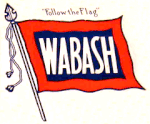Toledo, Wabash and Western Railway
 |
|

Wabash system map, early 20th century
|
|

The Wabash's City of St. Louis streamliner in the 1950s.
|
|
| Reporting mark | WAB |
|---|---|
| Locale | |
| Dates of operation | 1837–1991 |
| Successor | Norfolk and Western Railway |
| Track gauge | 4 ft 8 1⁄2 in (1,435 mm) |
| Length | 2,524 miles (4,062 kilometres) |
| Headquarters | St. Louis, Missouri |
The Wabash Railroad (reporting mark WAB) was a Class I railroad that operated in the mid-central United States. It served a large area, including track in the states of Ohio, Indiana, Illinois, Iowa, Michigan, and Missouri and the province of Ontario. Its primary connections included Chicago, Illinois; Kansas City, Missouri; Detroit, Michigan; Buffalo, New York; St. Louis, Missouri; and Toledo, Ohio.
The Wabash's major freight traffic advantage was the direct line from Kansas City to Detroit, without going through St. Louis or Chicago. Despite the Wabash name disappearing in the 1960s, the company continued to exist on paper until being merged into the Norfolk Southern Railway in 1991.
At the end of 1960 Wabash operated 2,423 miles of road on 4,311 miles of track, not including Ann Arbor and NJI&I; that year it reported 6,407 million net ton-miles of revenue freight and 164 million passenger-miles.
The source of the Wabash name was the Wabash River, a 475-mile (764 km)-long river in the eastern United States that flows southwest from northwest Ohio near Fort Recovery, Ohio across northern Indiana to Illinois where it forms the southern portion of the Illinois-Indiana border before draining into the Ohio River, of which it is the largest northern tributary. The name "Wabash" is an English spelling of the French name for the river, "Ouabache." French traders named the river after the native Miami tribe's word for the river.
...
Wikipedia
